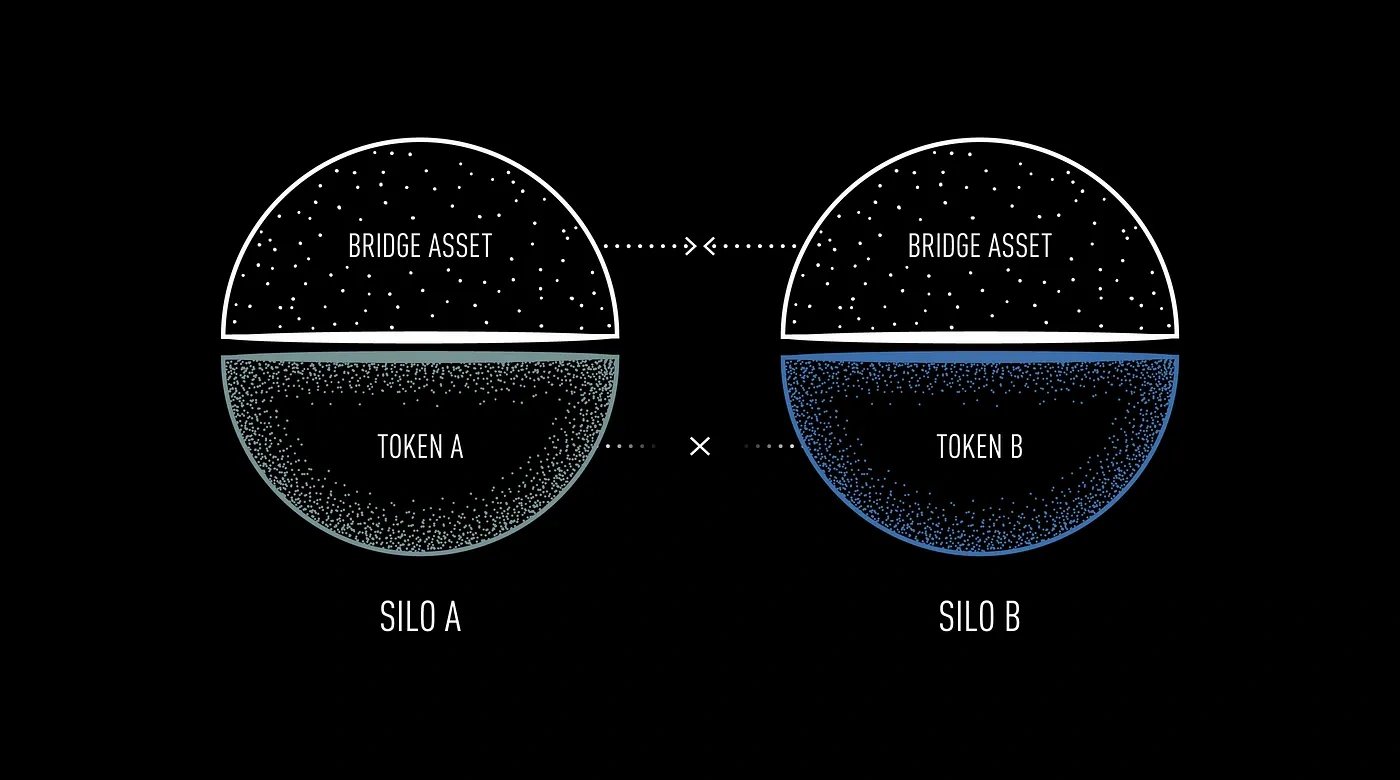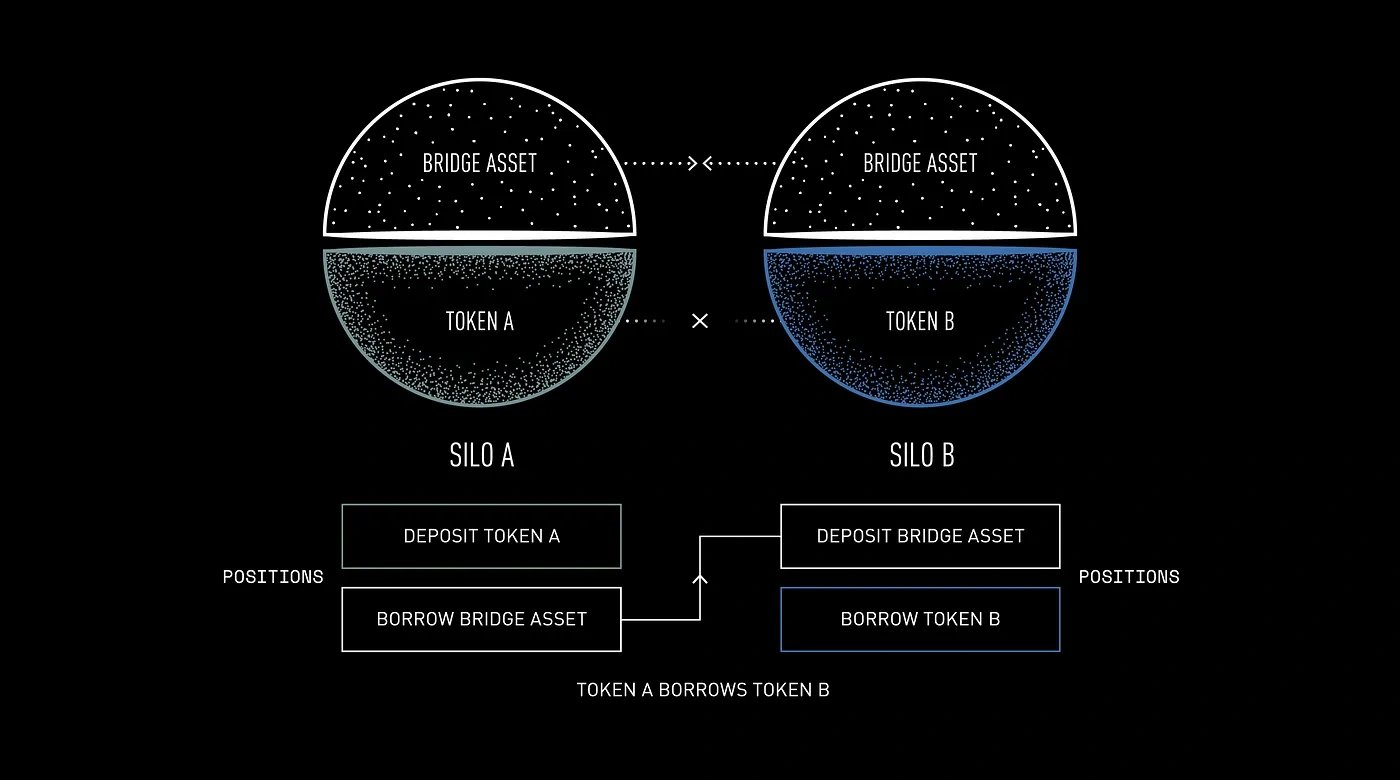위키 구독하기
Share wiki
Bookmark
Silo Finance
Silo Finance
Silo Finance는 다양한 암호화폐 자산의 차용 및 대출을 용이하게 하려는 비수탁형 대출 프로토콜입니다. 사용자가 토큰을 예치하여 이자를 얻거나 담보로 사용하여 다른 암호화폐를 빌릴 수 있는 위험 격리 대출 시장을 제공합니다.[1][2]
개요
2021년에 설립된 Silo Finance는 Silo라고 알려진 격리된 대출 시장을 제공하는 비수탁형 대출 프로토콜입니다. 각 Silo는 ETH 또는 스테이블코인과 같은 기본 자산과 브리지 자산을 포함하도록 설계되어 시스템적 노출을 방지하기 위해 개별 시장에 대한 위험을 격리하는 것을 목표로 합니다.
Silo Finance는 프로토콜 전반에 걸쳐 위험을 공유하지 않음으로써 다른 대출 시장에 상장하기 어려운 틈새 토큰을 포함한 모든 토큰에 대한 대출을 지원하는 것을 목표로 합니다. 이자율은 토큰의 이자율 모델과 현재 이용률에 따라 알고리즘 방식으로 조정됩니다. 거버넌스는 토큰 보유자가 의사 결정 과정에 참여하는 분산형 자율 조직(DAO)에 의해 관리됩니다.[1][2][3][4]
아키텍처
Silo
Silo Finance에서 Silo는 기본 자산(예: wstETH)과 브리지 자산(예: ETH 및 USDC와 같은 스테이블코인)으로 구성된 격리된 자금 시장입니다. 이러한 설정은 위험을 개별 Silo에 국한하여 프로토콜 전반에 걸친 시스템 위험 가능성을 줄이는 것을 목표로 합니다.[3][5]
기본 자산
Silo Finance에서 각 Silo에는 브리지 자산을 차용하기 위한 담보로 사용할 수 있고 그 반대의 경우도 가능한 단일 토큰 자산인 기본 자산이 할당됩니다. 각 Silo는 하나의 기본 자산만을 수락하므로 토큰 XYZ에 영향을 미치는 문제는 토큰 ABC와 브리지 자산만을 담보로 수락하는 Silo ABC에 영향을 미치지 않습니다. 이러한 위험 분리는 전체 프로토콜 위험을 손상시키지 않고 다양한 토큰에 대한 새로운 Silo를 생성할 수 있도록 합니다.
이 프로토콜은 담보, 보호된 담보, 부채를 위한 세 가지 ERC-20 토큰을 사용합니다. 사용자는 예치금을 차용할 수 있도록 할지 아니면 보호된 담보로 유지할지 여부를 결정할 수 있습니다. 시스템은 이러한 토큰을 주조 및 소각 기능으로 관리하며 거래 알림을 포함합니다.[3][5]

브리지 자산
Silo Finance에서 ETH와 같은 브리지 자산은 모든 시장에서 공유되는 토큰으로, 모든 Silo에서 담보 또는 차용을 위한 사용을 용이하게 하는 것을 목표로 합니다. 이를 통해 브리지 자산을 연결하여 여러 Silo에서 포지션을 생성할 수 있습니다. 브리지 자산의 예치는 특정 Silo에 국한되어 다른 Silo와의 격리를 보장합니다.
예를 들어, 토큰 XYZ에 부정적인 사건이 발생하는 경우 Silo XYZ의 브리지 자산 예치자만 영향을 받을 수 있으며, Silo ABC의 예치자는 영향을 받지 않습니다. ERC-20과 호환되는 브리지 자산은 Silo를 연결하고 Silo 간 운영을 관리하기 위한 것입니다. 이는 Silo 저장소에서 감독하며, 거버넌스는 포함 및 운영 역할을 조정할 수 있습니다.[3][6][7]

담보 요소
Silo Finance에서 담보 요소는 대출 대 가치(LTV), 청산 임계값, 청산 패널티 및 오라클과 같은 매개변수를 사용하여 각 Silo 내에서 위험을 관리하도록 설계되었습니다. 담보 요소는 시장 변동성과 온체인 유동성을 고려하여 토큰과 Silo에 따라 다릅니다.
위험이 높은 토큰은 대출자에게 더 큰 안전 마진을 제공하기 위해 더 보수적인 담보 요소를 갖습니다. 예치금은 차용 가능하거나 보호될 수 있습니다. 차용 가능한 예치금은 차용자에게 대출될 때 이자를 얻는 것을 목표로 하며, 대출되지 않고 이자를 얻지 못하는 보호된 예치금은 여전히 담보로 사용될 수 있습니다.[3][8]
이자 모델
Silo Finance의 이자율 모델은 차용된 토큰과 예치된 토큰의 비율에 따라 이자율을 조정하여 최적의 이용률을 유지하는 것을 목표로 합니다. 시스템은 유동성의 균형을 맞추기 위해 다양한 이용률에 따라 이자율과 그 변화율을 증가 또는 감소시키는 동적으로 반응하려고 합니다.
Silo Finance는 토큰당 Silo별로 적용할 수 있는 다양한 이자율 모델을 사용하여 다양한 토큰 유형에 대한 세부적인 사용자 지정을 허용합니다.[3][9]
토큰 경제
Silo Finance 토큰 ($SILO)
$SILO는 SiloDAO의 거버넌스 토큰 역할을 합니다. 투표를 통해 프로토콜 의사 결정에 참여하는 것을 용이하게 하는 것을 목표로 합니다.[12]
잘못된 내용이 있나요?
